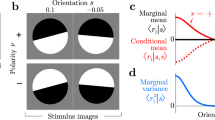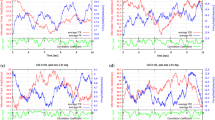Abstract
We explore how the reconstruction efficiency of fast spike population codes varies with population size, population composition and code complexity. Our study is based on experiments with moving light patterns which are projected onto the isolated retina of a turtle Pseudemys scripta elegans. The stimulus features to reconstruct are sequences of velocities kept constant throughout segments of 500 ms. The reconstruction is based on the spikes of a retinal ganglion cell (RGC) population recorded extracellularly via a multielectrode array. Subsequent spike sorting yields the parallel spike trains of 107 RGCs as input to the reconstruction method, here a discriminant analysis trained and tested in jack-knife fashion. Motivated by behavioral response times, we concentrate on fast reconstruction, i.e., within 150 ms following a trigger event defined via significant changes of the population spike rate. Therefore, valid codes involve only few (≤3) spikes per cell. Using only the latency t 1 of each cell (with reference to the trigger event) corresponds to the most parsimonious population code considered. We evaluate the gain in reconstruction efficiency when supplementing t 1 by spike times t 2 and t 3. Furthermore, we investigate whether sub-populations of smaller size benefit significantly from a selection process or whether random compilations are equally efficient. As selection criteria we try different concepts (directionality, reliability, and discriminability). Finally, we discuss the implications of a selection process and its inter-relation with code complexity for optimized reconstruction.
Similar content being viewed by others
References
Ammermueller J, Muller JF, Kolb H (1995) The organization of the turtle inner retina: II. Analysis of color-coded and directionally selective cells. J Comp Neurol 358: 35–62
Barnes GR (2008) Cognitive processes involved in smooth pursuit eye movements. Brain Cogn. 68: 309–326
Behrens R, Collewijn H, Grusser OJ (1985) Velocity step responses of the human gaze pursuit system. Experiments with sigma-movement. Vis Res 25: 893–905
Chichilnisky EJ, Kalmar ER (2003) Temporal resolution of ensemble visual motion signals in primate retina. J Neurosci 23(17): 6681–6689
Dunteman GH (1984) Introduction to multivariate analysis. Sage Publications Inc., Beverly Hills, California, USA, pp 107–152
Fernández E, Ferrández JM, Ammermueller J, Normann RA (2000) Population coding in spike trains of simultaneously recorded retinal ganglion cells. Brain Res 887: 222–229
Ferrández JM, Bongard M, Garcíade Quirós F, Bolea JA, Ammermueller J, Normann RA, Fernández E (2001) Decoding the population responses of retinal ganglions cells using information theory: connectionist models of neurons, learning processes and artificial intelligence. Lecture notes in computer science 2084. Springer-Verlag, Heidelberg
Ferrández JM, Bongard M, García de Quiráos F, Bolea JA, Fernández E (2002) Neural coding analysis in retinal ganglion cells using information theory. Lecture notes in computer science 2415
Frechette ES, Sher A, Grivich MI, Petrusca D, Litke AM, Chichilnisky EJ (2005) Fidelity of the ensemble code for visual motion in primate retina. J Neurophys 94: 119–135
Freund JA, Schimansky-Geier L, Beisner B, Neiman A, Russell DF, Yakusheva T, Moss F (2002) Behavioral stochastic resonance: how the noise from a Daphnia swarm enhances individual prey capture by juvenile paddlefish. J Theor Biol 214: 71–83
Gautrais J, Thorpe S (1998) Rate coding versus temporal order coding: a theoretical approach. Biosystems 48: 57–65
Gollisch T, Meister M (2008) Rapid neural coding in the retina with relative spike latencies. Science 319: 1108–1111
Granda AM, Fulbrook JE (1989) Classification of turtle retinal ganglion cells. J Neurophys 62(3): 723–737
Green DM, Swets JA (1966) Signal detection theory and psychophysics. Wiley, New York
Greschner M, Thiel A, Kretzberg J, Ammermueller J (2006) Complex spike-event pattern of transient \({{\tt ON-OFF}}\) retinal ganglion cells. J Neurophys 96(6): 2845–2856
Lewicki MS (1998) A review of methods for spike sorting: the detection and classification of neural action potentials. Network 9(4): R53–R78
Lisberger SG, Morris EJ, Tychsen L (2003) Visual motion processing and sensory-motor integration for smooth pursuit eye movements. Annu Rev Neurosci 10: 97–129
Manly BFJ (2004) Multivariate statistical merhods: a primer, 3rd edn. Chapman & Hall/CRC, USA, pp 105–108
Meister M, Berry MJ II (1999) The neural code of the retina. Neuron 22: 435–450
Pola J, Wyatt HJ (1991) Smooth pursuit: response characteristics, stimuli, and mechanisms. In: Carpenter RHS (eds) Vision and visual dysfunction. The Macmillan Press Ltd, London
Robinson DA (1965) The mechanics of human smooth pursuit eye movement. J Physiol, Lond 180: 569–591
Schreiber S, Fellous JM, Whitmer D, Tiesinga P, Sejnowski TJ (2003) A new correlation-based measure of spike timing reliability. Neurocomputing 52–54: 925–931
Stemmler M (1996) A single spike suffices: the simplest form of stochastic resonance in model neurons. Network 7: 687–716
Taketani, M, Baudry, M (eds) (2006) Advances in network electrophysiology using multi-electrode arrays. Springer, Berlin
Thiel A, Greschner M, Eurich CW, Ammermueller J, Kretzberg J (2007) Contribution of individual retinal ganglion cell response to velocity and acceleration encoding. J Neurophys 98: 1–12
Thorpe S, Fize D, Marlot C (1996) Speed of processing in the human visual system. Nature 381: 520–522
Thorpe S, Delorme A, Van Rullen R (2001) Spike-based strategies for rapid processing. Neural Netw 14: 715–725
Uzzell VJ, Chichilnisky EJ (2004) Precision of spike trains in primate retinal ganglion cells. J Neurophys 92: 780–789
Warland D, Reinagel P, Meister M (1997) Decoding visual information from a population of retinal ganglion cells. J Neurophys 78: 2336–2350
Winzenborg I, Thiel A, Harmand P, Greschner M, Kretzberg J (2010) Reconstruction of stimulus features based on spike rates and response latencies of population spike data. Submitted on March 2010
Author information
Authors and Affiliations
Corresponding author
Rights and permissions
About this article
Cite this article
Cerquera, A., Freund, J. Fast estimation of motion from selected populations of retinal ganglion cells. Biol Cybern 104, 53–64 (2011). https://doi.org/10.1007/s00422-011-0418-x
Received:
Accepted:
Published:
Issue Date:
DOI: https://doi.org/10.1007/s00422-011-0418-x




